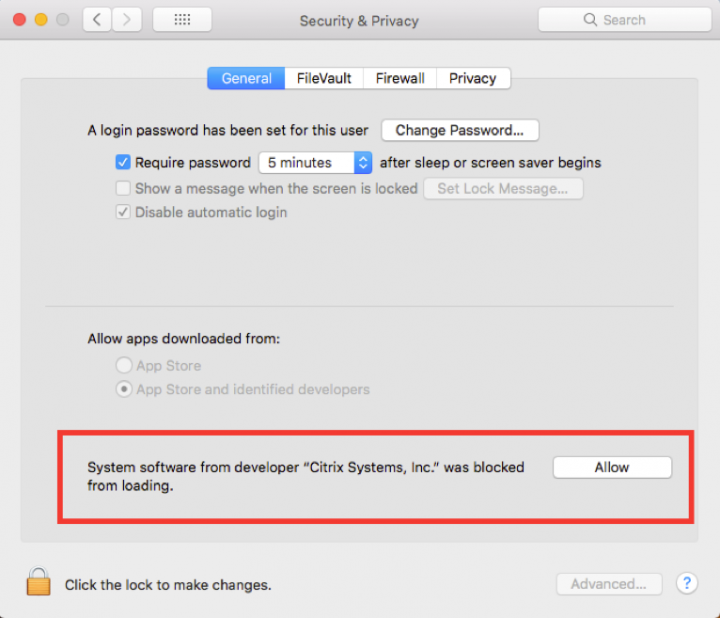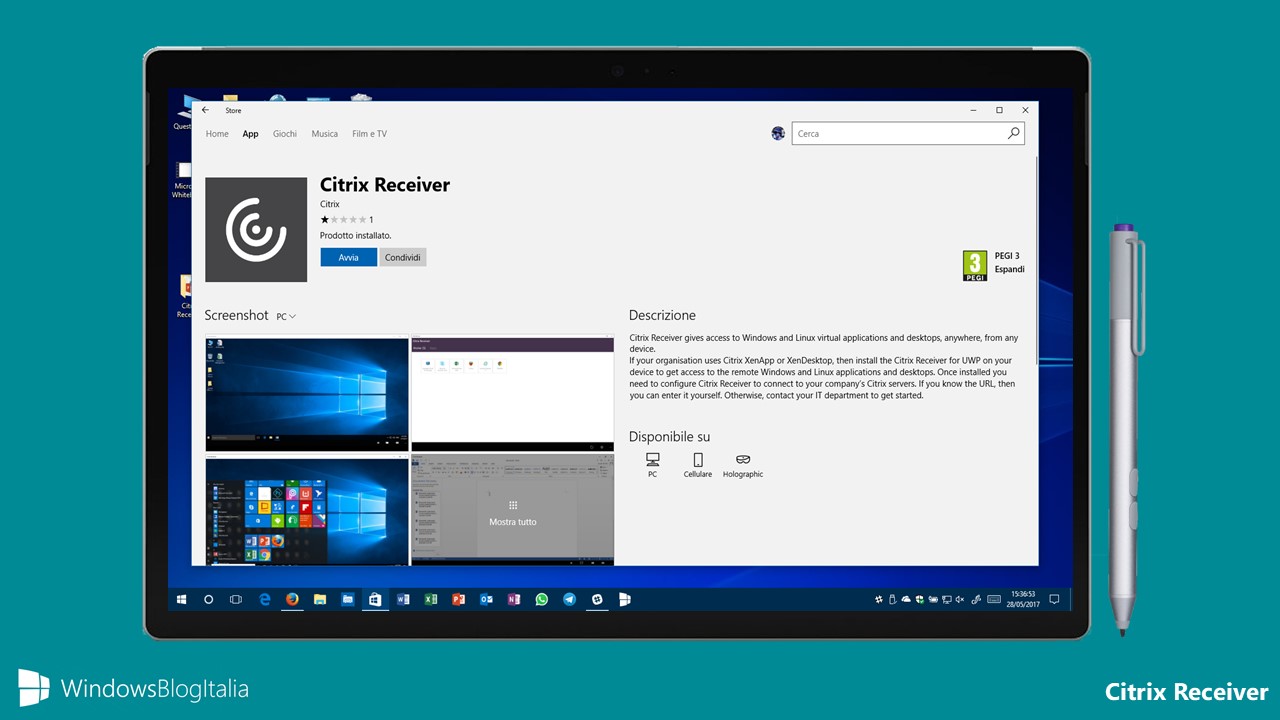Jun 22, 2020 Beginning August 2018, Citrix Receiver will be replaced by Citrix Workspace app. While you can still download older versions of Citrix Receiver, new features and enhancements will be released for Citrix Workspace app. Citrix Workspace app is a new client from Citrix that works similar to Citrix Receiver and is fully backward-compatible with. Citrix Workspace App; Receiver; Created Date: Modified Date. Citrix Workspace app CommandLine tool is a graphical user interface to.
- The Citrix Workspace app allows for secure, unified access to all of your SaaS apps, web apps, virtual apps, files, and desktops. If your company uses Citrix, simply login with your company credentials to access all of the resources you need to be productive from anywhere.
- The Citrix Workspace app allows for secure, unified access to all of your SaaS apps, web apps, virtual apps, files, and desktops. If your company uses Citrix, simply login with your company credentials to access all of the resources you need to be productive from anywhere.
Applicable Products

- Receiver for Windows
Objective
Citrix Receiver is a suite of products that allow client devices to connect to various desktop virtualization services offered by Citrix. This article has instructions to install, configure and use Windows Receiver.
Instructions
Installation and Configuration
Navigate to https://www.citrix.com/go/receiver.html in a web browser, then click Download Receiver. The newest version available would be Receiver 4.6.
Find the downloaded file and launch it.
Check the box next to “I accept the license agreement”, then click Next.
Choose whether to enable single sign-on. Single sign-on remembers the user’s credential for the device, so the user can connect to other Citrix applications without logging on. Then begin the installation.
Configuration and Logging on
After installation, you will find the receiver icon on the toolbar. Right click on it and select Open.
You can choose to enter either the corporate email address if IT team has configured the address, or the server address provided by IT. Then click Add.
Then enter the domain user name and password, then choose Log On.
Using Citrix Windows Receiver
Citrix receiver interface is now loaded, and all the resources can be seen from StoreFront.
Click FAVORITES to view the desktops and apps you added to FAVORITES
You can also view the assigned desktops by clicking the DESKTOPS
Then click Details; You can add these desktops to FAVORITES, open and restart the desktops.
After clicking APPS, you can view all available applications.
Click Details to add the applications to FAVORITES and open the apps.
Citrix Receiver for Windows provides users with secure, self-service access to virtual desktops and apps provided by XenDesktop and XenApp. Apart from using the windows receiver interface, users can also use the receiver with storefront from the website.
Secure User Environment
To maximize the security of the environment, the connections between Citrix Receiver for Windows and the resources you publish must be secured. You can configure various types of authentication for Citrix Receiver for Windows software, including smart card authentication, certificate revocation list checking, and Kerberos pass-through authentication.
1. Configure domain pass-through authentication
To enable domain pass-through using the graphical user interface:
Locate the Citrix Receiver for Windows installation file (CitrixReceiver.exe).
Double click CitrixReceiver.exe to launch the installer.
In the Enable Single Sign-on installation wizard, select the Enable single sign-on checkbox to install Citrix Receiver for Windows with the SSON feature enabled. The image below illustrates how to enable single sign-on:
2. Configure domain pass-through authentication with Kerberos

Citrix Receiver for Windows supports Kerberos for domain pass-through authentication for deployments that use smart cards. Kerberos is one of the authentication methods included in Integrated Windows Authentication (IWA).
When users install Citrix Receiver for Windows, include the following command-line option: /includeSSON. This option installs the single sign-on component on the domain-joined computer, enabling Citrix Receiver for Windows to authenticate to StoreFront using IWA (Kerberos). The single sign-on component stores the smart card PIN, which is then used by the HDX engine when it remotes the smart card hardware and credentials to XenDesktop. A related option, ENABLE_SSON, is enabled by default and should remain enabled.
To apply the settings, restart Citrix Receiver for Windows on the user device. After that, users also need to configure StoreFront:
- In the default.ica file located on the StoreFront server, set DisableCtrlAltDel to false.
- When you configure the authentication service on the StoreFront server, select the Domain pass-through check box. That setting enables Integrated Windows Authentication. You do not need to select the Smart card check box unless you also have non domain joined clients connecting to Storefront with smart cards.
Citrix Receiver Apple

3. Configure smart card authentication
a. To enable single sign-on for smart card authentication
To configure Citrix Receiver for Windows, include the following command-line option when users install it: ENABLE_SSON=Yes. Single sign-on is another term for pass-through authentication. Enabling this setting prevents Citrix Receiver for Windows from displaying a second prompt for a PIN.
b. To enable user devices for smart card use
- Import the certificate authority root certificate into the device's keystore.
- Install your vendor's cryptographic middleware.
- Install and configure Citrix Receiver for Windows.
- Details on certification installation can be found here in - https://docs.citrix.com/en-us/citrix-workspace-app-for-windows/system-requirements.html
c. To change how certificates are selected
Change how certificates are selected by using either of the following methods:
- On the Citrix Receiver for Windows command line, specify the option AM_CERTIFICATESELECTIONMODE={ Prompt | SmartCardDefault | LatestExpiry }.
- Add the following key value to the registry key HKCU or HKLMSoftware[Wow6432Node]CitrixAuthManager: CertificateSelectionMode={ Prompt | SmartCardDefault | LatestExpiry }.
d. To use CSP PIN prompts
Change how PIN entry is handled by using either of the following methods:
- On the Citrix Receiver for Windows command line, specify the option AM_SMARTCARDPINENTRY=CSP.
- Add the following key value to the registry key HKLMSoftware[Wow6432Node]CitrixAuthManager: SmartCardPINEntry=CSP.
4. Enabling certificate revocation list checking
When certificate revocation list (CRL) checking is enabled, Citrix Receiver checks whether or not the server’s certificate is revoked. By forcing Citrix Receiver to check this, users can improve the cryptographic authentication of the server and the overall security of the TLS connection between a user device and a server.
Advanced Preferences
Users can right click on the receiver icon on the toolbar and select Advanced Preferences to view an advanced preferences list like the picture below.
The Citrix Connection Center displays all connections established from Citrix Receiver. The Connections window displays a list of active sessions. Each server entry in the list represents a session. For each seamless session, below each server entry, a list of the hosted resources you are running on that server appears. The Connection Center offers various options to view statistics and control sessions and applications.
Resetting receiver will delete all apps, desktops, accounts and configurations, and will return receiver to default settings. It will also close all active sessions. This feature will only be used to serious problems.
When users click Settings Options in the advanced Preferences menu, users then will have 2 tabs. Users can choose the application display settings and reconnect options in this two tabs.
If users delete the passwords, users are asked for the password the next time they log in.
Data collection is designed to ask users whether they agree to send anonymous data and usage statistics to Citrix, which help Citrix to provide better products.
Starting with Release 4.5 of Citrix Receiver for Windows, Configuration Checker helps users to run a test to ensure Single sign-on is configured properly. The test runs on different checkpoints of the Single sign-on configuration and displays the configuration results.
When users log in to the Citrix Receiver for Windows, users can launch a published desktop session. From the Desktop Viewer toolbar, users can select Preference to configure some preferences.
When click File access, users can choose the way that they want to use to access files on the computer. It contains 4 ways: read and write, read only ,no access and ask me each time.
When comes to the connection part, users can choose how devices, including microphone, webcam, digital camera and scanner, will connect to the virtual session. Also, there is a Relative Mouse setting providing an option to interpret the mouse position in a relative rather than an absolute manner. This capability is required for applications that demand relative mouse input rather than absolute.
The display part provides a choice about the way the virtual desktops display. We recommend our users to use the Best Resolution since this kind of resolution will fit the screen perfectly automatically.
The flash part provides a choice about whether user want to optimize the content of flash player. If users optimize content, the playback quality will be improved but the security will be reduced. If not, just basic playback quality will provided but with high security.
- When Receiver for Web detects that it is accessed from Edge, it does not prompt the user to install native Receiver. Instead, a download link is provided in the user dropdown menu to download native Receiver.
- Once selected, the Receiver download screen is displayed and the user can download and install native Receiver.
- After the user selects the checkbox to agree with the license agreement and clicks the Download button, the user is brought back to the main screen where applications and desktops are shown.
- After Receiver for Windows is successfully installed, the user can select an application to launch. If the Receiver for Web site is not a trusted site, the user will be prompted to open the .ica file.
- As you may have noticed, there is no option in the UI to make Edge always open .ica file. If this occurs, it means that the Receiver for Web site is not trusted. You can add the Receiver for Web site to the Trusted Sites or Intranet Sites. This can be done using Group Policy for domain-joined client machines. Once you have done this and restarted Edge, applications should be launched without any further prompt.
- If you are manually adding the Receiver for Web site to the Trusted or Intranet Sites, there is no obvious way to do it in Edge itself. You have to do it via Windows Settings. First, select Settings from the Start menu.
- Type in “Internet Options” in the search box on the pop-up window.
- Select Internet Options in the search result. You will get the familiar Internet Options window.
Install Citrix For Windows 7
Receiver for HTML5Citrix Receiver App For Mac
- If you configure the Receiver for Web site to use Receiver for HTML5 as a fallback for launching applications, users will get Receiver for HTML5 by default as Receiver for Web cannot detect whether the native Receiver is installed. In this case, a menu item is introduced for the user to select which receiver to use for launching applications.
- Once you select Change Receiver from the menu, Receiver for Web will tell you what version of Receiver you are using and enable you to select which Receiver to use. Please note that Receiver for Windows is referred to as “full version” in the UI and Receiver for HTML5 is referred to as “light version”.
Citrix Receiver App Not Working
Additional Resources
